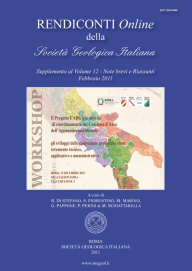
I risultati dei primi rilevamenti del Progetto CARG in Abruzzo
Ernesto Centamore (*), Mario Costa (**) & Pio Di Manna (***)
(*) Coordinatore Scientifico F° 358, 359, 360, 368, 369, Via Muzio Clementi 58, 00193 Roma. E-mai: ernesto.centamore@hotmail.it
(**) Aquater S.p.A., Via Selvelli Prosperi 6, 61032 Fano (PU). E-mai: joset@libero.it
(***) Servizio Geologico d'Italia, ISPRA, Via Curtatone 3, 00185 Roma. E-mail: pio.dimanna@isprambiente.it
DOI: https://doi.org/
Volume: 12/2011
Pages: 31-34
Abstract
The results of the first Abruzzo CARG Project mapping.
The sheets at the scale 1:50.000 358 - Pescorocchiano, 359 - L'Aquila, 360 - Torre dei Passeri, 368 - Avezzano, 369 - Sulmona represent the first products of the CARG Project for the Abruzzo Region.
Detailed field investigations, carried out on an area of about 3000 kmq, allowed us to acquire new data on bio-chronostratigraphy, physical and sequential stratigraphy, macro and mesostructural evidences. On the base of these new detailed data, the frame of the geological evolution of a complex Mesozoic-Cenozoic platform-slope-basin and ramp-basin systems have been reconstructed and a new detailed geological setting has been defined for the mapped region.
New evidences show the fundamental role played by tectonic inversion in the geological and structural evolution and in the geomorphologic, palaeo-environmental and sedimentary differentiation of the investigated sectors, starting from the post-drift stage (Upper Cretaceous p.p.), through the syn-orogenic foredeep stage (Lower Messinian) and up to the late compressional phase (late Lower Messinian-Middle Pliocene).
Moreover the new data confirm that, since the Middle Pliocene, this Apennine sector has been affected by an intense regional uplift, joined with an extensional tectonics, controlled by the formation of new normal faults and by the reactivation of pre-existing elements, often with new tectonic inversion processes, in a negative sense.
The scientific and technical value of these CARG project maps have been positively tested on the occurrence of the Mw 6.3, L'Aquila earthquake (April 6, 2009). The Paganica faults system (composed by four main apennine faults), to which the seismic event is ascribed, is exactly mapped in the sheet 359 - L'Aquila. Moreover the space-time arrangement of the hypocentres of this seismic sequence almost coincides with the main structural elements mapped in the Aterno – Velino valleys district, where the transversal/oblique faults, breaking the continuity of the apenninic structures, act as a barrier/release between the different sectors.
Keywords
Abruzzo geological map, CARG Project, geological and structural evolution, L'Aquila earthquake, stratigraphy, tectonic inversion
Get Full Text